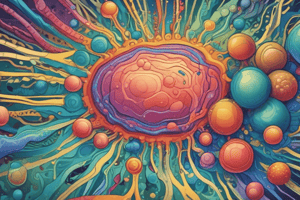Podcast
Questions and Answers
What is the consequence of the electrogenic pump (Na+/K+ pump) pumping 3 Na+ out of the cell and 2 K+ into the cell?
What is the consequence of the electrogenic pump (Na+/K+ pump) pumping 3 Na+ out of the cell and 2 K+ into the cell?
- The inside of the cell becomes more negative and the outside more positive (correct)
- The pump stops working
- The inside of the cell becomes more positive and the outside more negative
- The cell becomes electrically neutral
What is the function of membrane vesicles in bulk transport?
What is the function of membrane vesicles in bulk transport?
- To package large molecules for transport (correct)
- To synthesize proteins
- To generate ATP
- To store genetic material
What is the role of the proton pump in co-transport mechanisms?
What is the role of the proton pump in co-transport mechanisms?
- To directly transport amino acids into the cell
- To synthesize ATP
- To generate a gradient of H+ that drives the active transport of solutes (correct)
- To break down proteins
What is the process called when vesicles fuse with the plasma membrane to release their contents outside the cell?
What is the process called when vesicles fuse with the plasma membrane to release their contents outside the cell?
What is the type of endocytosis where the cell takes in specific molecules using receptor-mediated endocytosis?
What is the type of endocytosis where the cell takes in specific molecules using receptor-mediated endocytosis?
What is the organelle responsible for forming vesicles for exocytosis?
What is the organelle responsible for forming vesicles for exocytosis?
What is the primary function of transport proteins in the membrane?
What is the primary function of transport proteins in the membrane?
What is the role of glycoproteins in cell-cell recognition?
What is the role of glycoproteins in cell-cell recognition?
Which type of proteins forms a hydrophilic channel for selective permeability of solutes across the membrane?
Which type of proteins forms a hydrophilic channel for selective permeability of solutes across the membrane?
What is the function of membrane proteins in intercellular joining?
What is the function of membrane proteins in intercellular joining?
What is the purpose of membrane carbohydrates in cell-cell recognition?
What is the purpose of membrane carbohydrates in cell-cell recognition?
What is the role of channel proteins in membrane transport?
What is the role of channel proteins in membrane transport?
What is the purpose of lysosomes in cells?
What is the purpose of lysosomes in cells?
What is the process called when amoebas engulf smaller organisms or food particles?
What is the process called when amoebas engulf smaller organisms or food particles?
What is the main function of the Golgi apparatus in relation to lysosomes?
What is the main function of the Golgi apparatus in relation to lysosomes?
What is the composition of the outer mitochondrial membrane?
What is the composition of the outer mitochondrial membrane?
What is the purpose of vacuoles in cells?
What is the purpose of vacuoles in cells?
What is the site of tri-carboxylic acid cycle activity and ATP generation in cells?
What is the site of tri-carboxylic acid cycle activity and ATP generation in cells?
Flashcards are hidden until you start studying
Study Notes
Transport Proteins and Bulk Transport
- Electrogenic pumps generate voltage across a membrane, e.g., Na+/K+ pump and proton pumps in plants, fungi, and bacteria.
- The Na+/K+ pump pumps 3 Na+ out and 2 K+ in, making the inside of the cell more negative and the outside more positive.
- Co-transport (coupled transport) is an ATP-powered pump that indirectly drives the active transport of several solutes, e.g., a plant cell uses a proton pump to drive the active transport of amino acids, sugars, and other nutrients.
Bulk Transport across Membranes
- Water and small solutes enter and leave cells by diffusion or protein pumps.
- Large molecules like proteins and polysaccharides are packaged in membrane vesicles and require energy for transport.
- Cells secrete biological molecules through exocytosis, where vesicles fuse with the plasma membrane.
Endocytosis
- Endocytosis is the process by which cells take in biological molecules by forming new vesicles from the plasma membrane.
- There are three types of endocytosis: phagocytosis, pinocytosis, and receptor-mediated endocytosis.
Membrane Proteins
- Six major functions of membrane proteins:
- Transport proteins form hydrophilic channels for selective permeability of solutes across the membrane.
- Enzymatic activity, e.g., in cell metabolic pathways (ATP production).
- Signal transduction, where protein receptors bind to chemical messengers (e.g., hormones) to relay a message to the inside of the cell.
- Cell-to-cell recognition, where glycoproteins serve as identification tags recognized by membrane proteins of other cells.
- Intercellular joining, where membrane proteins of adjacent cells bind together via gap junctions or tight junctions.
- Attachment to the ECM, where microfilaments and microtubules are attached to membrane proteins to maintain cell shape and stabilize the location of membrane proteins.
Membrane Carbohydrates
- Membrane carbohydrates are attached to lipids (glycolipids) or proteins (glycoproteins) and function as markers to distinguish one cell from another, e.g., human blood types A, B, AB, and O.
Lysosomes and Vacuoles
- Lysosomes are membranous sacs of hydrolytic enzymes that cells use to digest macromolecules.
- Lysosomes carry out digestion in different circumstances, e.g., in amoebas, food vacuoles fuse with lysosomes to digest engulfed food particles.
- Vacuoles are large vesicles derived from the ER and Golgi apparatus, with selective transport of solutes, and can differ in composition from the cytosol.
Organelles Involved in Energy Conservation
- Mitochondria are the "powerhouses of the cell" found in most eukaryotic cells, site of tri-carboxylic acid cycle activity, and ATP generation by electron transport and oxidative phosphorylation.
Studying That Suits You
Use AI to generate personalized quizzes and flashcards to suit your learning preferences.




